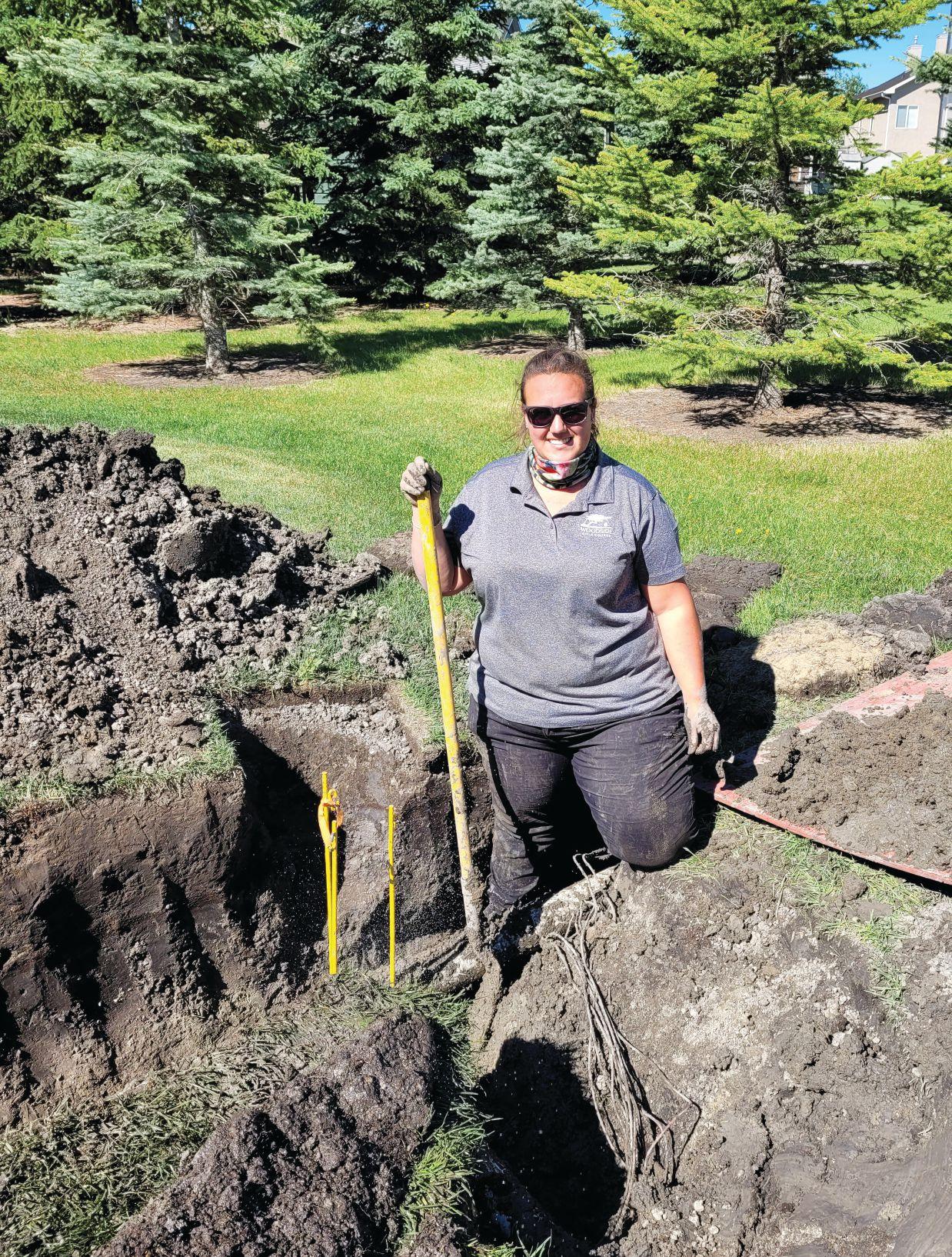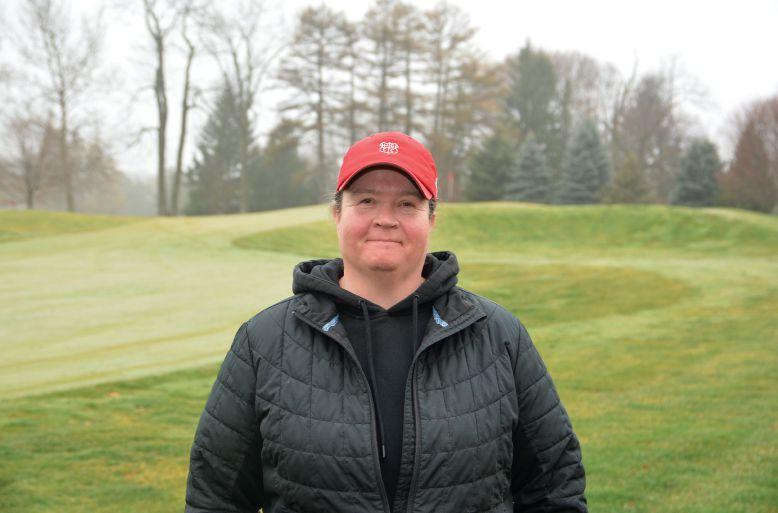





The FSA 135 R is the latest brushcutter in our battery-powered line-up that can be used in noise-sensitive situations. It is a lightweight, powerful and efficient choice for landscapers, municipal workers and those that have large yards to upkeep. The AP battery can be inserted directly into the powerhead, as opposed to using an adapter system. The ergonomic loop handle makes it comfortable to operate and easy-tomanoeuvre, while also providing a three-step speed adjustment with LED light. Built with a metal mesh air filter, it delivers a longer service life and provides optimum motor cooling. Also, a wide selection of cutting attachments can be used on the FSA 135 R to suit the job at hand.
NOTE: Bike handle version also available.

SPECIFICATIONS
VOLTAGE 36 V WEIGHT ② 9.2 LB (BIKE HANDLE) 10.8 LB
CUTTING HEAD AUTOCUT® C 26-2
① Battery and charger sold separately. ② Weight without battery.
Battery Power. Made by STIHL.
STIHL’s Pro-Fleet Commercial Landscape Program is designed to provide commercial landscapers a volume discount on purchases of five or more landscaping power tools. Receive additional savings on STIHL battery products until June 30, 2023. Visit your STIHL Dealer today to learn about our power, performance and durability difference.






MIKE JIGGENS

By Mike Jiggens
Turf & Rec’s initiative to honour key women in the turf and grounds maintenance industry has taken another step forward with this issue. Not only are we profiling another four women in the second part of a feature that began with the March issue, but we also have a separate story that delves into the role an Alberta assistant golf superintendent has played in launching a mentorship program for young women entering the industry or who are still amid their post-secondary studies.
The woman depicted on our cover this issue is Morgan Creighton, assistant superintendent at Woodside Golf Course in Airdrie, Alta. Prior to the COVID pandemic, she founded a mentorship program that helped young women across Canada find the confidence within themselves to enter a male-dominated industry to work as their equals.
The program has been praised by those who have benefited from it, including at least one of our eight selected honourees. The number of women who have been mentored through the program has been steadily growing since it began in 2019.
It has proven to be an effective way to help women get through the door. Many prospective female turf and
grounds maintenance employees might be a little apprehensive about what a male-heavy place of employment will be like and how they may be treated by their co-workers. It can be intimidating if a new employee finds herself alone as the sole woman amid a workforce of men.
Being able to speak with another woman who has faced the same challenge and learn how that individual dealt with the matter and moved on from it can be a calming effect and one that can propel newly hired women forward.
Not only has this industry been traditionally male dominated, but it arguably can be said that several years ago it was for
It has been an effective way to help women through the door
men only. That’s no longer the case, and more and more women have passed through this widening door in more recent years to pursue important careers in the field – many of which have seen women elevated to the upper echelons of their respective places of employment.
Many of the women we have honoured this year have climbed the ladder at their golf course, municipality or company because they had the confidence in themselves to be able to work among men and

make significant contributions on their own accord.
The stories of the eight women we have honoured this year can also be read on our website (www.turfandrec. com) and can be heard in a four-episode podcast series at www.turfandrec.com/womenin-turf/.
Feedback to our Women in Turf promotion has been positive, and inquiries about next year are already being made. There are undoubtedly countless others who deserve to be in the same spotlight, and the chance to formally nominate these individuals will be coming soon.
Our regular Guelph Turfgrass Institute feature in this issue takes a break from reporting on new research activities to go behind the scenes of a year experienced by students enrolled in the University of Guelph’s Diploma in Turfgrass Management Program.
One of the year’s highlights was the chance for 18 students to attend the Ontario Golf Superintendents Association’s annual conference in Blue Mountain, courtesy of BrettYoung. A group photo of the lucky students, published in this issue, shows three women among the group. That’s a one-in-six female representation. It speaks volumes about the growing number of women wishing to enter the industry.
One of the female students in attendance at the event remarked that the networking opportunities were her personal highlight, likening the experience to being one big family.
www.turfandrec.com
Reader Service
Print and digital subscription inquiries or changes, please contact Angelita Potal, Customer Service Tel: (416) 510-5113 apotal@annexbusinessmedia.com
Mail: 111 Gordon Baker Rd., Suite 400 Toronto, ON M2H 3R1
Editor Mike Jiggens mjiggens@annexbusinessmedia.com
Advertising Manager
Rebecca Lewis 519-400-0322 rlewis@annexbusinessmedia.com
Account Coordinator Trish Ramsay 416-510-6760 tramsay@annexbusinessmedia.com
Audience Development Manager
Anita Madden Tel: (416) 510-5183 amadden@annexbusinessmedia.com
Group Publisher Anne Beswick 416-410-5248 abeswick@annexbusinessmedia.com
President/COO
Scott Jamieson sjamieson@annexbusinessmedia.com
Printed in Canada ISSN 1186-0170
PUBLICATION MAIL AGREEMENT #40065710
SUBSCRIPTION RATES
Published 7 times a year – Jan/Feb, March, Apr/May, June/July, Aug/Sept, October, Nov/Dec
Canada – 1 year $35.00; 2 year $45.00 3 years $55.50 (plus applicable taxes HST 86717 2652 RT0001
Occasionally, Turf and Recreation will mail information on behalf of industry related groups whose products and services we believe may be of interest to you. If you prefer not to receive this information, please contact our circulation department in any of the four ways listed above.
Annex Privacy Office privacy@annexbusinessmedia.com Tel: 800.668.2374
No part of the editorial content of this publication may be reprinted without the publisher’s written permission © 2023 Annex Business Media. All rights reserved. Opinions expressed in this magazine are not necessarily those of the editor or the publisher. No liability is assumed for errors or omissions.
All advertising is subject to the publisher’s approval. Such approval does not imply any endorsement of the products or services advertised. Publisher reserves the right to refuse advertising that does not meet the standards of the publication.


80% of the bag contains Target Specialty Products’ proprietary organic granulated compost which is CFIA approved for use in Canada.
20% of the bag is grass seed, including
• Two certified varieties of Perennial Ryegrass, selected for:
- Spreading Ability;
- High Heat, Drought and Humidity Tolerance;
- Highest Cold Tolerance Rating;
- High Salt Tolerance;
• Certified Kentucky Bluegrass variety, selected for:
- Fast Germination/ Establishment
- Excellent Tillering
- High Wear Tolerance





A La Broquerie, Man. landscaper has won back-to-back gold medals at Skills Canada Manitoba’s landscaping/ gardening competition.
Kayla Wieler has won gold the past two years and went on to take spot last year in Vancouver as Skills Canada’s national champion. Her provincial gold medal allows her to compete in May at the national level competition in Winnipeg. She will be joined by her teammate Jacob Abbey of Winnipeg.
A major opening day celebration was planned for Noel Booth Community Park in Langley, B.C., but an act of vandalism which occurred Easter weekend has altered those plans.
Sometime between Good Friday and Saturday, vandals cut locks at two park gates to gain access to its baseball fields and drove a four-by-four vehicle on the grounds, creating doughnut ruts and rendering the field unplayable.
The local girls’ fastball leagues were ready to play their home openers this weekend.
St. John’s, NL’s Bally Haly Country Club is leaving its historic location in the city’s east end to occupy the former Clovelly Golf Club property. The club is being rebranded the Bally Haly Country Club at Clovelly Estates.
The move has reduced the number of golf courses in the St. John’s area to six from seven.
Golf Newfoundland and Labrador’s executive director says this makes the golf market more sustainable.
2number of consecutive gold medals won by landscaper

Equip Exposition, the international landscape, outdoor living, and equipment exposition, has opened registration for the 2023 trade show, to be held Oct. 17-20 at the Kentucky Exposition Center in Louisville.
“Equip Exposition is the experience of the year for anyone in the landscape, hardscape, outdoor living, and power equipment business,” Kris Kiser, president of the Outdoor Power Equipment Institute, which owns and manages the trade show, said. “Last year we saw a sold-out exhibit hall and brought more than 25,000 people to Louisville. As we celebrate 40 years of Expo together, it’s going to be a can’t-miss event.”
6
number of remaining St. John’s golf courses
Early bird discounted registration is available until Sept. 7. Attendees can register to attend for as little as $25 per person.
Last year, Equip Expo broke
records and attracted more than 25,000 attendees who hailed from all 50 U.S. states, Canada and 48 other countries, with the furthest traveling attendees journeying from Guam, New Zealand and Australia. The show brings more than $20 million in revenue to Louisville, and books more than 32,000 hotel rooms during show week.
In addition to Expo’s 30-acre outdoor demo yard and expansive indoor exhibit space, the event will feature several other major events for attendees:
• Expanded exhibit space in the West Wing allows exhibitors to showcase and demonstrate more products indoors.
• A first-ever Women’s Reception, open to all women attending Expo to network and connect. Learn more and register at www. equipexposition.com.
Salmon Arm, B.C.’s growing cricket club is looking for a field to call its own.
The Salmon Arm Cricket Club, which has about 25 members, has been playing games of late at a local elementary school field, but is seeking a dedicated field of its own. The club has made a request for a field to city council, stating it wishes a proper facility to train interested players and promote the game.
The club said it would raise about $10,000 it estimates would cover the cost of a pitch but hoped the city would approve a site and give permission to prepare the pitch and ground.
Hamilton’s city-owned golf courses are under review again to determine their viability as community green spaces.
The review is intended to see if King’s Forest and Chedoke golf courses are serving the public’s interest in the best way. The city’s emergency and community services committee approved a request to review the courses’ finances, including their capital needs, the number of rounds played and their environmental management.
Chedoke has been operating since 1896 while King’s Forest opened for play in 1974. King’s

Forest was last profitable in 2010. Selling the properties for development is a tricky matter because of their location on the Niagara Escarpment where urban redevelopment isn’t permitted. The city had agreed in 2017 to no longer review a land sale or residential development on the golf course properties.








By Mike Jiggens
As Turf & Rec continues to celebrate women in turf for a second consecutive issue, one notable woman has been working behind the scenes to ensure other women entering the industry are afforded an immediate sense of comfort and confidence.
This is especially important when newly hired women find themselves among the minority in a male-dominated industry.
Morgan Creighton, assistant superintendent at Woodside Golf Course in Airdrie, Alta., launched a program in 2019 to help relieve the fear that many women contemplating a career in turf might possess. Having a mentor to look up to is something she relishes, and she figured establishing a mentorship program might be beneficial to other women who might harbour certain reservations about joining a male-dominated workforce.
“For some of these women, there’s no other female around them,” Creighton said. “It’s good just to be able to have people to turn to that have a different type of commonality.”
The mentorship program has recruited a roster of more than 80 mentors, including golf course superintendents and assistants, educators and other women working in the industry. As of the spring, there were 21 female students involved in the program who are seeking mentorships. Those just entering the industry or who are still amid their post-secondary academic studies are paired with seasoned female professionals,

giving them a chance to network and connect at an early stage in their career.
Although based in Alberta, the program is open to all young women across Canada while efforts are underway to offer mentorship opportunities to those in the United States as well. Creighton’s role as co-ordinator of the program is purely voluntary, and she does everything on her own time.
The program began with about 60 mentors and six students and is operated via What’s App and Zoom.
“Each of the students is paired into a mentor group, and each year when new students come in, they get paired into an already created mentor group. So that network’s building instead of just creating individual groups for each student.”

The mentored students have their own group chat as well as interaction with their mentor groups, “and that’s kind of where the magic really happens.”
Creighton said the students are supportive of one another and wish to see each other succeed. There are women in the students’ group who have graduated from the program and have migrated to the mentor side.
Establishing a network of mentors began with Creighton contacting other Alberta women she knew from the industry who were receptive to the program’s mission. From there, she reached out to other provincial golf superintendents’ associations to gauge interest from some of their long-standing female members.
“Once I had a group of female contacts, I then created a Google form for them to fill out. It was kind of a personality test to see what they felt their strengths
were and what their career path has been.”
Creighton said when the students seeking mentorships were recognized, it allowed them to be aligned with mentors who could help them get work visas for internships in the United States or overseas.
Although there were some well-established women in the industry who turned down the call to be mentors – mainly due to time restraints or an incompatible lifestyle – the mentorship recruitment process was “very successful.”
Due to the demands of the golf industry during the busy summer months, it can sometimes be challenging to maintain a steady conversation between mentor and student, she said.
“There’s a bit of ebb and flow in there in trying to continue a conversation. The students love it so far –just the fact that they’re able to meet so many different women, and especially since I’ve been able to host in-person events once again so that they can physically create that bond.”
Through Zoom meetings, students within their own group discuss topics they’d like to address with their mentor groups. One of the biggest things they seek is the development of a network and getting to know others like them. They discuss common issues and find it beneficial to turn to someone else as a sounding board. Creighton said it’s more of a gathering of opinions from people in the industry who can provide sound advice that might not necessarily be as professional as that coming from friends or family members.
She said that when she first began in the golf industry, an assistant superintendent at her first course encouraged her to study turfgrass management at Olds College.
“He was the person who made me fall in love with the industry.”
Two of her Olds classmates were women, but she said often is the case when a student finds herself alone in a class of men. Creighton didn’t have a mentor at the time which, she said, made it tougher for her.
Creighton is looking to expand the mentorship program into the United States.
Things are different now. She worked at a few other courses before joining the staff at Woodside in April 2021, and cites current superintendent Karen Rumohr as her mentor.
“She is absolutely phenomenal, and she’s the one I turn to for everything. She’s very level-headed and logical thinking. That really works with me and how I learn.”
Creighton grew in a “very outdoorsy” family and was mowing lawns and cutting trees at a young age. While in high school, she sought the type of summer employ-
Visit one of these participating Exmark Dealers to learn more about the full line of professional Exmark models.
CALGARY CALGARY RED DEER
ABBOTSFORD BURNABY
COURTENAY KAMLOOPS
KELOWNA N VANCOUVER
NANAIMO SURREY
VERNON
ALTONA HEADINGLEY ST ANDREWS
ALBERTA FOREST & GARDEN .
BROTHERS TWO SMALL ENGINES INC . FUTURE AG INC
403-248-0878
403-279-2244
403-343-6101
FORESHORE EQUIPMENT AND SUPPLY . FORESHORE EQUIPMENT AND SUPPLY .
PILON TOOL RENTALS 1972
B & L SMALL MOTORS LTD
SAVOY EQUIPMENT
FORESHORE EQUIPMENT AND SUPPLY .
WALKER’S SAW SHOP LTD
ARCOM POWER EQUIPMENT INC
SAVOY EQUIPMENT
ALTONA FARM SERVICE LTD ..........
HEPBURN ENTERPRISES INC .........
ST. ANDREWS PARTS & POWER .......
BOUCTOUCHE RIVERVIEW
B.M. MARINE INC
CR YARDWORKS & EQUIPMENT INC
MILFORD
ONTARIO
ARVA BRADFORD BRAMPTON BRANTFORD BURLINGTON
COURTLAND
DUNDAS ELMIRA
EMERYVILLE
EXETER HAMILTON
MAXWELL
MILLBANK
MISSISSAUGA
MISSISSAUGA
MISSISSAUGA
MITCHELL
MOUNT FOREST
STRATHROY
SUDBURY
VARS
WALLACEBURG
WELLAND
WINDSOR
THE TRACTOR DOME INC
HURON TRACTOR LTD
BRADFORD RENTAL SALES & SERIVCE
GREEN TRACTORS INC
BOBCAT OF BRANTFORD INC
B.R. DICKSON EQUIPMENT INC
BLUE WEST EQUIPMENT INC
WPE LANDSCAPE EQUIPMENT
MARTIN’S SMALL ENGINES LTD
CAMPEAU OUTDOOR POWER EQUIP.
HURON TRACTOR LTD
OUTDOOR SUPPLIES & EQUIPMENT
MAXWELL FARM SERVICE INC
ZEHR’S SALES AND MANUFACTURING
CURRENT POWER MACHINERY INC
W.E. ENTERPRISES LTD
WPE LANDSCAPE EQUIPMENT
MITCHELL CYCLE INC
BROADLINE EQUIPMENT LTD
CAMPBELL’S OUTDOOR POWER EQUIP.
SUDBURY SMALL ENGINE
M.R. BLAIS SALES & SERVICE INC
THE OUTDOOR STORE
DAVE’S SMALL ENGINES
VEHICLE VENTURE
LLOYDMINSTER
WICKHAM NURSERYLAND ...........
604-744-0547
604-436-9312
250-338-5361
250-376-0033
250-868-1010
604-924-9400
250-585-1320
604-533-0081
250-545-0627
204-324-5523
204-889-3392
204-953-0030
506-743-8566
506-854-0333
902-758-2220
519-666-2300
905-775-7101
905-846-2511
519-752-7900
905-331-5040
519-688-0909
905-628-3055
519-669-2884
519-727-5031
519-235-1115
905-578-2411
519-922-2108
519-595-7579
905-822-4211
905-629-1424
905-569-2055
519-348-0490
519-323-3591
519-245-2428
705-564-9772
613-443-1230
519-627-4844
905-732-2344
519-966-8642
306-825-3262
‘There was a point in my career when I was harassed daily’
ment that would allow her to work outside and not at a mall where some of her contemporaries found work. Landing a job at a golf course was right up her alley. She said being an early riser allowed her to finish earlier in the afternoon, leaving her the rest of the day for herself. After finishing high school, however, she thought a career teaching school was her calling, but after only one year of study, “I realized I didn’t want to be inside full-time to teach. I wanted to be outside. I wanted to be on a golf course.”
After graduating from Olds, she took a brief hiatus from golf for a municipal job in turf and forestry, learning new skills in tree maintenance and being able to identify hazard trees and how to safely remove them.
“I wanted to get back to a golf course after a couple of years there,” Creighton said, noting her journey took her to a nine-hole course near the Rocky Mountains and a 45hole property along the Elbow River in Calgary before landing at Woodside.
Creighton has faced several challenges throughout her career in golf, including working with men who were disrespectful to women.
“There was a point in my career when I was harassed
daily,” she said. “I can withstand a lot and I can take a lot, but then I saw the person doing it to a kid – a 16-year-old who was just a summer student – and I wanted to do something because I couldn’t let that happen. I went to HR (human resources) and it made it worse. It got to the point where it was easier for me to walk away and leave than it was for me to continually put myself in that position.”
Creighton said that incident from her past – which left her in “a deep depression” – was among the deciding factors that inspired her to take the “leap” toward helping other women.
She was one of 50 women who attended Bayer’s inaugural “women in golf” event in Raleigh, N.C., and said having so many women come together and support one another was a positive experience and helped her found a Canadian-based mentorship program.
“We’re in a day and age where it’s unacceptable to be in a non-inclusive and derogatory environment. Things are slowly turning for the better.”
To contact Creighton for more information about the mentorship program, email her at morgan@woodsidegc. com.







The second part of a twopart feature, profiling eight of the leading women working in the Canadian turf and grounds maintenance industry.
By Mike Jiggens
Turf & Rec is recognizing four more women employed in the professional turf and grounds maintenance who have made names for themselves over the years for their work ethic, innovation and leadership qualities.
In the March issue of Turf & Rec , we profiled four women who fit the bill in the first of our two-part “Women in Turf feature.” In this issue, we feature Brittany Sammut, equipment operator (IPM) for the City of Guelph, Ont.; Patricia Sloan, spray technician at the Kamloops, B.C. Golf & Country Club; Tracy Fowler, assistant superintendent at the Hamilton, Ont. Golf & Country Club; and Jennifer Lemcke, CEO of The Weed Man.
Extended versions of each of these women’s stories can also be heard in a fourpart podcast series found at our website.
Patricia Sloan
Golf course maintenance is in Patricia Sloan’s blood. She got her first taste of the industry directly from her father, Rob, superintendent at the Cardinal Golf Club in King, Ont., when she was 14 years old.

Although she worked for him during her summers while in high school, a career in the business didn’t appear to be in the cards.
Sloan opted to study hotel and resort management in college but returned to the golf course to work “here and there.” She ended up making her way to Whistler, B.C. to work in hotel management, but soon

came to grips with her true love.
“Looking back now, I don’t know what I was thinking about hotel and resort management,” she said. “It seemed too easy to go into turf. Looking back, it was a bad call on my part.”
The move to British Columbia didn’t go for naught, however.
“I really fell in love with B.C. and knew

Get maximum uniformity and longevity in the field with proven TTS-800 Series Golf Rotors. Featuring a powerful, high-torque gear drive for harsh water conditions and Total-Top-Serviceability for easy, no-dig maintenance, these reliable rotors make irrigation management simple, round after round.
Exclusive PressurePort™ Nozzle
Technology optimizes incoming pressures to maximize distribution uniformity for greener, healthier turf


hunter.info/TTS800
I wanted to stay out in B.C. I just had to change from resort management to turf management.”
Sloan found employment at the Whistler Golf Club and later at Sun Peaks Golf Course, where she was assistant superintendent. The seclusion of Sun Peaks and its comparatively shorter season – late May to September – didn’t sit well with her, and she moved about 60 kilometres south to Kamloops to become the spray technician at the Kamloops Golf & Country Club where she applies all fungicides and herbicides to greens, fairways and clubhouse turf based on products superintendent Travis Olson prescribes.
“I was looking for something that was a little bit of a longer season and a little more year-round. That’s what initially drew me to Kamloops.”
Sloan cites a multitude of career high-
lights from her 17 years in the industry.
“I’ve had a lot of opportunities arise… as far as meeting other women in the industry, being part of the mentorship program (a program founded by Morgan Creighton, assistant superintendent at Airdie, Alta.-based Woodside Golf Course), and I was invited to North Carolina a couple of years ago for another women in turf event, so every opportunity that has been given to me has been great.”
What Sloan said she enjoys most about her chosen career is the chance to work outdoors and the challenges that it can present.
“It’s different every day. You wake up in the morning and you don’t know what you’ll walk into. It could be great, it could be bad, but either way it’s going to be a good day.”
For women who might be thinking

about following in her footsteps, she offers this advice:
“My biggest piece of advice, and it’s something I sometimes still struggle with, is the confidence that you’re making the right decision, the confidence that you know what you’re doing and feeling comfortable voicing your opinion and your thoughts – 100 per cent confidence.”
Like Sloan, Tracy Fowler’s initiation into the golf turf industry came courtesy of a close relative – in this case an uncle who was, at the time, an assistant superintendent at the Hamilton Golf & Country Club.
Offered a summer job at the age of 15 at the Ancaster, Ont. private golf course, Fowler was handed a garbage bag on her first day of work and was sent to pull weeds from bunkers.



“I absolutely hated it,” she recalled. “It was the worst two weeks of my life. All I did was work and sleep. It was so hot, and I was so tired that I wanted to quit, but I didn’t want to disappoint. I stuck it out and thankfully I did.”
She returned to work the next several summers, “and loved every minute of it.”
The change of heart proved to be fortuitous. Fowler now counts 36 years of working in the golf industry.
On the road to her current position as an assistant superintendent at the Hamilton club, she worked a short time at the Brantford Golf & Country Club, where an assistant superintendent encouraged her
to enrol in the two-year diploma program at the University of Guelph. Her 1994 graduation led to a return to the Hamilton club and an offer from former superintendent Rhod Trainor to join the staff as an assistant superintendent.
Fowler said she’s been asked several times why she’s remained in the same role at the same club for so many years, but she says she’s happy where she is and doesn’t relish the idea of a longer commute. She was born and raised in Ancaster, has parents who live nearby and has children attending a local school.
“I just put my head down and I worked. I’ve seen so many people come and go. Do I regret not moving on? Maybe some days. Do I think I should have tried something new? Maybe. I don’t dwell on it.”
Among the highlights of Fowler’s career at the Hamilton Golf & Country Club has

been her involvement in preparing the course for four Canadian Open tournaments on the PGA Tour. The club is the host venue again next year for another Open.
“I enjoy most watching it through someone who’s never experienced it before through their eyes,” she said of Canadian Open course preparations. “It’s one of the coolest things you’ve ever seen.”
Another aspect she enjoys about her role as an assistant is to watch new hires rise through the ranks and perhaps move on to higher positions elsewhere, or to see young people join the staff, get married and have children of their own.
Fowler said one of the things she enjoys most about working at Hamilton is the camaraderie among the staff and how supportive the employees are of one another. There are no issues related to working with others who are mostly male, she says.
“We’ve got along just fine. We respect each other and work well together.”
Jennifer Lemcke
Jennifer Lemcke also got an early start in the professional turf industry. She did some odd jobs for her father when she was 16, shortly after he purchased his first
Weed Man franchise in Quebec.
Some years later, she and her then boyfriend, Chris (now her husband), purchased an existing franchise in the Ottawa area. Building the franchise several-fold over the next six years, they acquired more than 40 other franchises from company founders and owners Des and Brenda Rice.
Des died in 2018, and Brenda offered to sell the company to the Lemckes soon afterward. Today, Jen nifer Lemcke is CEO of The Weed Man corpora tion and has worked full-time for the company in one capacity or another for 30 years.
Although the company was founded and remains headquartered in Canada, it began expansion into the United States in 1996. The venture into the U.S. market proved to be a shrewd business decision and one which has involved Lemcke’s attention the most. She has led the U.S. expansion in franchising.

U.S., compared with 99 in Canada. Revenue-wise, U.S. sales are about $220 million and $89 million in Canada. The company services more than 600,000 residential customers across North America.
The Weed Man is focused on its core competency, Lemcke said, adding the relationship the company has built with its franchisees is one of trust.

“We’re very laser focused on the franchisees’ success, and it just works for us.”
Working with both her father and husband are cited among her career highlights. Family, however, extends beyond them, she said. Six members of her staff have been working with her for 27 years while others have been co-workers for 10 to 12 years, creating a familylike atmosphere in which they spend time with each other outside of traditional business hours.
“I was just super focused on the U.S.”
Today, The Weed Man is much larger in the United States than it is in Canada. The company has 245 licence agreements is the
Working with others is what Lemcke says she enjoys most – “100 per cent.”
Being a woman in a male-dominated industry is something that has worked out well for Lemcke, and other women can

follow suit, she said.
“Don’t just expect it. You’ve got to work hard.”
She added women can’t expect to be treated differently because of their sex.
“The industry needs to understand that we do bring a different perspective to the table. Bringing a woman in can bring a sense of difference and allow change to happen.”
Women tend to be more creative in certain areas, more organized and more diligent toward detail, she added.
“In the end, you want to work somewhere that is accepting of you and that is going to challenge you. Don’t take the challenges as a knockdown.”
Brittany Sammut entered the turf world as a summer student working for the City of Guelph while studying criminal justice public policy at the University of Guelph. As a member of the university’s women’s rugby team, which won the Canadian national championship during her final year, she developed an appreciation for sports field upkeep and fell in love with turfgrass.
Her summer work presented new opportunities, and Sammut was soon enrolled in the university’s turf manager’s short course to learn more.
“Not knowing anything about turf, I went in with full enthusiasm being one of two other women in the course, which I was shocked to see at the time,” she said.
Sammut said the course proved to be a little intimidating for her, especially after choosing to drop all math and science courses in high school.
Completing the short course, however, opened new doors for her, and she soon found herself in a newly created position as Guelph’s integrated pest management (IPM) equipment operator in 2019.
“It’s a brand-new position. I take care of all the cultural practices, the overseeding, irrigation, aeration and topdressing, and take care of the specialized turf down at the Guelph Lawn Bowling Club.”


Sammut was given the opportunity to build the IPM program as she saw fit. It was initiated to ensure Guelph’s sports fields and other green spaces could be effectively managed amid Ontario’s ban on several pest control products. She said the city’s high-end sports fields warrant extra attention and require the pertinent cultural practices.
“I still feel like I’m a rookie. I definitely want more experience just to get that under my belt.”
Getting used to weather conditions that tend to change daily is a challenge Sammut said she faces when trying to schedule cultural practices on city fields.
“There’s limited time to get the lawn bowling (green) prepped every morning. We work 7 to 3, so it doesn’t give us much time to get everything completed.”
Morning work on the bowling green
includes blowing off worm castings and leaf debris, and, with game play starting at 10 a.m., little time remains for cultural practices.
One day a month is set aside for spraying, dethatching and topdressing.
Despite the challenges, Sammut is enjoying her career.
“I absolutely love working outdoors and having the opportunities to meet and train new staff every season.”
She said she also enjoys offering the fields’ user groups the best possible playing conditions.
Sammut said the city fosters inclusion and diversity in its hiring practices, and she feels she’s on equal footing with her male colleagues. About 52 per cent of Guelph’s sports and leisure services employees are female.
Women wishing to enter the turfgrass

industry should have an open and positive mind and be willing to ask lots of questions, she said.
“Try not to take the easy way out. Things can get complacent at times. Keep challenging yourself to accomplish more. Be adaptable because everything is constantly changing.”


Neighbours of a well-maintained property will become future clients, veteran landscaper says.
By Mike Jiggens
Great work gets noticed, and landscape contractors who provide their customers with superior workmanship will acquire additional clientele who are willing to pay top dollar. The trick is to go the extra mile, leaving behind a clean, aesthetically pleasing property.
Such was the message from Brad Paton, president of Shades of Summer Landscaping and Maintenance in Hamilton, who shared his maintenance philosophies with attendees at Nutrite’s 13th annual spring lawn care seminar at the Guelph Turfgrass Institute. He made the same presentation at Landscape Congress in January.
“If you’re doing good work and people know who you are, you’ll get more work out of it,” he said.
Paton founded his business in 2009 after having worked as maintenance manager at Evergreen Landscaping in Hamilton for 17 years. He has won Canadian Nursery Landscape Association awards in grounds maintenance with both companies.
It’s the maintenance division of a land-
scaping business that is responsible for the longest-lasting relationship between the client and the company. A designer may deal with a customer for a month or so before passing things over to the installer. The installer may spend a few days to a month working with the customer, but the company’s maintenance wing will deal directly with the client from a year to several years. Paton said he has customers he’s been serving for 30 years.
“You’ve got to realize that with the relationship that you cultivate with the client, the person who maintains it often has the strongest relationship with the homeowner.”
Once a property is installed with trees, shrubs and other plantings, it’s the maintenance contractor who is responsible for keeping everything healthy, growing and tidy year after year. The impression the maintenance contractor leaves with the client is the key to retention and procuring new customers.
“If you have nicely maintained properties, their neighbours will be your future
clients. If you left a lot of leaves all stuffed in bushes and there’s no snow on the ground, that’s the impression you left your client. Always be respectful to the neighbours as they are your next client.”
Paton said it’s advantageous to have clusters of customers in the same general area to prevent having to drive several blocks between clients and continually park and unload trucks.
A professionally maintained property is apt to lead neighbouring homeowners to hire that same company, building a customer base within the same neighbourhood.
Fall cleanup is an important seasonal task and cannot be compromised.
“Do a really good job, clean it up nicely and don’t leave anything. Clean it up as best you can. Go as late as you can in the season, even if it’s into December.”
Leaves are collected in the fall by the company’s Walker mowers, ensuring there are no stragglers. Leaving a property spot-
less in the fall bolsters the contractor’s relationship with the customer.
“When clients want their places clean, do an amazing fall cleanup because it leads to much better things in the springtime.”
Customers tend to be annoyed when they see such things as leaves stuck in hedges as well as other work that appears incomplete.
In the spring, most of the lawns serviced by Shades of Summer are dethatched. Paton said as the decaying matter is pulled out, the lawn is opened for the season’s first fertilizer application. While some companies will aerate their customers’ lawns in the spring, Paton said he doesn’t wish to risk damaging a property’s irrigation system, adding aeration is best done in mid-May than in early April.
Many customers like to have their gardens and tree bases mulched to add aes-
thetic appeal to their properties. Some property owners still prefer red-dyed mulch, but Paton said it’s a trend that is no longer in vogue.
“If you’re going to put something on top of your garden, make sure it’s feeding your plants as well as containing the soil moisture.”
Shades of Summer’s mulch preference is a product called Gro-Max which is a premium garden soil formulated for maximum root growth with a blend of compost, aged bark fines, peat, sand and is free of weed seeds.
Mulch is driven by aesthetics which is why many customers are attracted to black-dyed mulch. Paton said there is nothing detrimental about the product but noted nothing beneficial is being added to gardens.
Gro-Max has a dark black colour which
is retained at the end of the season while black-dyed mulch turns white and needs to be topped up year after year, he added.
The timing for mulching is also critical, Paton said, noting it’s “a pain in the butt” to mulch in June or July.
“If you’re going to be doing mulching, do it first thing in the spring. It’s way easier when the gardens are completely empty, and then all your perennials come up through the mulch and that gets you set up for the season.”
Edging flower beds and getting mulch in early sets the tone for the rest of the season, Paton said.
Larger mulching jobs are done with a blower truck. When more than 15 yards of material are required, mulch is blown into place.
“It’s easy and makes you look really professional.”

Subscribe to the Turf & Rec eNewsletter for first access.


Paton uses a 24-0-10 fertilizer formulation from Nutrite which he applies four times in the spring, summer and fall. Some landscaping companies sub-contract fertility applications to lawn care businesses, but he said he likes to maintain continuity with his customers.
“One thing you can offer the client that a fertilizer company cannot is that you’re there every week.”
Another advantage Shades of Summer realizes by doing its own fertility applications is that it can time the work based on weather patterns better. If the forecast projects a hot and humid week, for example, the application can be made the following week or perhaps a week beforehand. Paton said lawn care companies with hundreds of customers tend to stick to a schedule and may not apply at the
most opportune time.
About 80 per cent of the properties maintained by Shades of Summer are irrigated, and many have their control boxes located on the outside of the home. Boxes installed on the exterior of homes allow contractors greater control when conditions are dry, especially if the homeowner is going to be away for a significant length of time.
The system might be programmed to irrigate a couple of days a week, but a prolonged period of drought might require lawns to be watered every day.
“A lot of homeowners hire us because they want us to do that. If you have control of the irrigation and it’s raining, you have the control to shut it off.”
ai1681314469190_De Groot 3.475 x 4.75 Ad.pdf 1 2023-04-12 11:47:50 AM
Although some maintenance contractors prefer to leave mulched grass clippings on the lawn to return nutrients to the soil,

Paton prefers to collect all clippings.
“The reason I do it is because it’s neat and clean and tidy.”
Contractors who choose to leave clippings on the lawn often find much of it has drifted onto adjacent driveways and sidewalks. When blown back onto the lawn, other debris often is mixed in.
“The most important thing we do for bagging grass is ensure the weed seeds don’t go back into the grass.”
Paton argued that collecting clippings and weeds helps to reduce mowing frequencies and weed growth.
Blowing clippings and other debris from curbs is also important, he added, because it’s part of the property that must be kept neat and tidy.
“Blowing stuff up and over the curb and onto the lawn is OK because we’re going to bag it.”


By Dr. Sara Stricker and Cam Shaw
The Diploma in Turfgrass Management (DTM) program at the University of Guelph provides a practical hands-on approach to learning about managing turfgrass, whether it be for golf, professional sports, lawn care or sod. The program balances theory-based learning with applicable on-the-job training and is sure to set anyone up for a successful career in turfgrass management. Including the rigorous course work, the students in our program have had many amazing extracurricular opportunities this year, such as attending conferences, participating in the Golf Course Hockey Challenge, and inviting speakers from the industry to attend Turf Club meetings. Arguably the favourite course for our students is The Turf Industry. This course introduces the many disciplines within the
industry and emphasizes their learning through field trips to various turfgrass operations and companies that supply the turfgrass industry.
This year, the course included field trips to golf courses, sports fields, a sod farm and more. On one of the field trips, the firstyear students travelled to an aggregate quarry to learn about how root zone materials are mined, processed, and sold. Our students were enthusiastic about learning all the elements of the turf industry from the ground up.
“At the quarry it was really cool to see the process of aggregates being broken down to various sizes for different industry needs,” DTM student Michael Banton said. “The next time we receive a truck load of divot mix or bunker sand to the club, I will understand how much time and work was involved in that process.”
During the COVID-19 pandemic, many of the hands-on and in-person learning opportunities were cancelled or modified following public health regulations. One program that returned in 2023 – to much excitement – was the Superintendent in Residence (SIR). This unique program invites an experienced industry professional to spend a few days on campus with the Diploma in Turfgrass Management and Turf Managers Short Course students.
The SIR program last occurred in February 2020, after which it became difficult to invite guests to campus. We had decided against hosting a virtual version since this program really focuses on interactions, informal discussions and social outings.
This year, we invited Chris Tritabaugh from Hazeltine National Golf Club to travel from Minnesota to Guelph to spend time with our turf students and to give a
public lecture. The SIR presentation was hosted on March 1, 2023 at Cutten Fields, and Chris gave an impassioned speech about collecting data to better understand what we are doing and why.
Specifically, he wanted to reduce negative experiences by user groups since practices like aeration, topdressing, and verti-cutting can impact player experience. Chris explained how he interprets the data from the stimpmeter and bobble test to: a) ensure his greens are in the best possible condition across the entire playing season, and b) communicate to the members what to expect when the turf needs more ag-
gressive management.
The SIR presentation was attended by many University of Guelph turf students, faculty, instructors, and local industry professionals. The energy in the room was invigorating with lots of feedback, discussion, and questions from the audience. Everyone was happy to be back in person. It was a great opportunity for our students to gain exposure to real-world professionals, expand their professional network, as well as for us to improve our curriculum based on feed-back provided by Chris.
We send our thanks to the sponsors of the SIR program who made that event a success.
Again, thanks to the support of turf industry partners, our students had the amazing opportunity to attend two conferences this year. In January, the Ontario Golf Superintendents Association and BrettYoung supported 18 students to attend the OGSA conference in Blue Mountain. This conference included informative talks on soil health, bunker construction and maintenance, pest management and more. In addition, Dean Baker, DTM instructor and superintendent at Burlington Golf and Country Club, was awarded the 2023 William Sansom Distinguished Service Award at this event.

“OGSA was my first conference in the turf industry,” DTM student Amy Bultena said. “The variety of topics and speakers was eye opening and filled with so much wonderful information. The networking opportunities and people you meet or re-connect with was the best part. It was like having one big family in a room! Blue Mountain was such a good spot for having everyone right there, and we gratefully appreciate the support of BrettYoung and the OGSA which allowed us to attend.”
Also, for the first time since the pandemic, our students had the opportunity to attend the GCSAA conference and
23_001274_Turf_Rec_APR_MAY_CN Mod: March 21, 2023 10:44 AM Print: 03/21/23 11:39:14 AM page 1 v7


trade show in Orlando, Fla. Thanks to the support of Syngenta Canada, we sent three teams of DTM students to the conference where they participated in the GCSAA Collegiate Turf Bowl competition. Students from across the United States and Canada competed in teams of four and were tested on their knowledge of agronomy, business management, turf identification, environmental management and leadership. This year, our teams placed 14th, 20th and 21st out of 63 teams.
“I am very grateful for this opportunity of attending the GCSAA conference and trade show,” DTM student Matty Rodrigues said. “It was truly an amazing experience seeing how big this event is and all that goes into it. Based on the GCSAA’s blog, this event was attended by 69 per cent more people than the 2022 event in San Diego. I came back from Orlando with much more knowledge and experience from talking with people from the industry about so many different things. I can’t wait to attend again in the future.”
The DTM students are required to complete a minimum 15-week industry work placement between April and September. This placement was recently reformatted from an internship to a co-op. This change means that the hands-on experience will be recognized by certain provincial governments to qualify for potential tax rebates.
In the summer of 2023, our students will work at many prestigious locations, includ-

ing BMO Field, Fairmont Banff Springs Golf Course and Oakmont Country Club in Pennsylvania. Last summer, six of our students volunteered on the grounds crew for the RBC Canadian Open tournament at St. George’s Golf and Country Club and were even given the honour of changing pins during the event. What a great opportunity!
“Over the course of my internship, I was lucky to be surrounded by turfgrass managers who were not only extremely welcoming, but eager to share their wealth of knowledge and experience,” DTM 2022 graduate Doug Nisbet said. “Prior to the start of to my placement, I submitted a list of learning objectives to the courses, outlining some of the areas and tasks I’d hoped to tackle. It was clear from day one that completing this list was as important to my supervisors as it was to me, if not more.”
Historically, our students have found


exciting work placements at golf courses and other turfgrass-based enterprises across Canada as well as in the United States, Australia, New Zealand, England, Scotland, Germany and the Caribbean. Graduates of our program are in high demand within the turfgrass industry across Canada and internationally.
“Everyone involved in the DTM program from faculty staff, students and industry professionals has been so incredibly accepting,” Banton added. “We’re like family.”
If you are interested in hiring a DTM co-op student or graduate, please contact Cam Shaw (cshaw12@uoguelph.ca), and you can connect with the GTI on social media @GuelphTurf.
Dr.






Inside this book are proven techniques that enable you to design, build, and manage an efficient and safe turf maintenance facility for golf courses, parks, and sports complexes. Backed by more than fifty years of collective experience, the authors assist you in developing and implementing costeffective preventive maintenance programs that rely on the latest technology to optimize the performance of turf equipment. Moreover, with its detailed coverage of safety regulations and regulatory agencies, the book helps ensure the safety of everyone who works in the shop or uses the turf equipment.

By CCOHS
The Canadian Centre for Occupational Health and Safety (CCOHS) promotes the total well being of workers in Canada by providing information, training, education, systems and solutions that support health and safety programs and injury and illness prevention. www.ccohs.ca
Workplace harassment and violence happens
more often than you may think. According to a recent national study (published in 2022) conducted by Western University, the University of Toronto and the Canadian Labour Congress, 71 per cent of respondents experienced at least one form of harassment or abuse at work in the two years prior to completing the study survey.
Any worker or workplace, across any sector or industry, can be affected by harassment and violence. These acts can have devastating effects, including physical and psychological harm, a hostile working environment, and increased absenteeism and turnover.
All workers have the right to feel safe, protected and respected at work. To help reduce the risk to workers who may work alone, in skeleton crews, or in precarious environments, having a harassment and violence prevention program can help.
An important first step in ensuring a safe work environment is to define and understand the many forms of harassment and violence.
Whether a series of incidents or a single act, workplace harassment can involve unwelcome behaviours or comments meant to demean,

embarrass, or provoke a reaction. Workplace violence, including physical assault, psychological trauma, family violence, and sexual assault, can be any action, threat or gesture that can cause harm, injury or illness. Bullying is also a form of harassment and violence and can involve acts that cause psychological harm or negative physical contact.
Some work settings are more vulnerable to harassment and violence than others due to their location, activity, or hours of operation. Working alone or in small numbers, and in the late evening or early morning can put workers at greater risk for this unwelcome behaviour. Other factors that can put someone at greater risk include gender, persons in equity-seeking groups, and persons with disabilities.
Since each workplace is unique, it is important to understand what can contribute to harassment and violence. A risk assessment can help de -
termine which hazards are present and the risk they represent to your workers. Starting with an inspection of the work environment, focus on the tasks being done, and your administrative and work practices. Consider internal factors such as your work culture, conditions, activities, and organizational structure. Also consider external factors, including work site locations, clients, customers, and any history of family violence.
It’s good practice to review previous incidents of harassment and violence by consulting existing incident reports, first aid records, and health and safety committee records, if applicable. You might also request information from any organizations or industry associations you’re associated with, the union (if applicable), or from the workers’ compensation board, and occupational health and safety regulators.
Once you’ve collected this information, review it for trends and identify the occupations and locations that you
believe are most at risk. Record the results of your assessment and use this to develop a prevention program with specific steps for reducing the risk of harassment and violence.
The most important aspect of any prevention program is management or leadership commitment, best communicated through a written policy. Your harassment and violence prevention policy should be developed with input from workers or representatives including the health and safety committee and the union (if present). It should apply to management, workers and anyone who has a relationship with the organization and should be easily accessible to everyone.
The policy should inform workers about what behaviours are inappropriate and unacceptable at work, what to do when incidents occur, how to report them, and the procedure that will be followed when they are reported.
You can help foster a culture of safety by encouraging workers to report any incidents they experience or witness, without fear of reprisal, by introducing a confidential reporting process.
Outline the procedures for investigating and resolving incidents and determine how information about potential risks will be communicated to workers while maintaining confidentiality of the parties involved.







